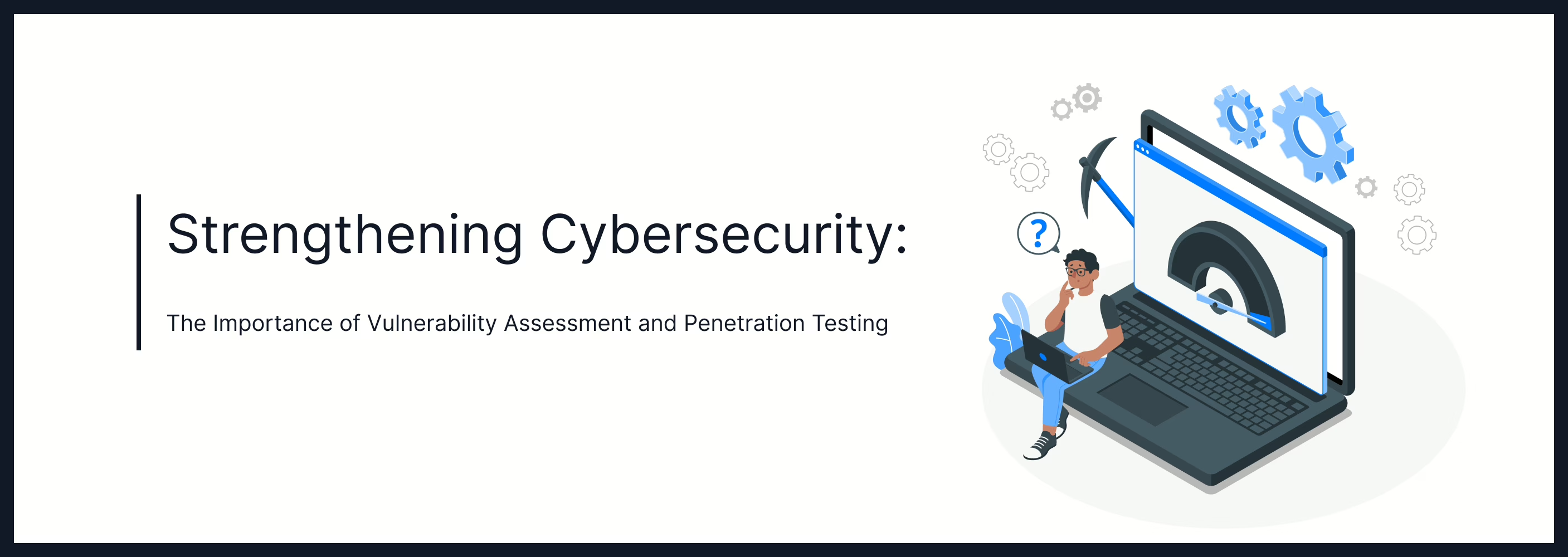
Oct 15, 2024 Information hub
Strengthening Cybersecurity: The Importance of Vulnerability Assessment and Penetration Testing
In today’s digital age, where businesses and individuals rely heavily on technology, cybersecurity has become a critical concern. With the increasing number of cyberattacks, data breaches, and sophisticated hacking techniques, organizations must take proactive steps to protect their digital assets. One of the most effective ways to do this is through Vulnerability Assessment and Penetration Testing (VAPT).
VAPT is a crucial process that helps organizations identify, assess, and mitigate vulnerabilities in their systems, networks, and applications. It involves two distinct but complementary activities: vulnerability assessment, which focuses on identifying potential weaknesses, and penetration testing, which simulates real-world attacks to exploit those vulnerabilities. Together, these processes provide a comprehensive understanding of an organization’s security posture and help prevent potential cyber threats.
In this blog post, we will explore the significance of vulnerability assessment and penetration testing, their relevance in today’s cybersecurity landscape, practical examples, current trends, challenges, and future developments. We will also discuss the benefits of implementing VAPT and provide actionable recommendations for organizations looking to enhance their security measures.
The Importance of Vulnerability Assessment and Penetration Testing
What is Vulnerability Assessment?
A vulnerability assessment is a systematic process of identifying, quantifying, and prioritizing vulnerabilities in an organization’s IT infrastructure. It involves scanning systems, networks, and applications to detect potential security weaknesses that could be exploited by malicious actors. The goal is to provide a comprehensive list of vulnerabilities, along with their severity levels, so that organizations can take appropriate action to mitigate them.
What is Penetration Testing?
Penetration testing, often referred to as “ethical hacking,” is a simulated cyberattack on a system, network, or application to identify and exploit vulnerabilities. Unlike vulnerability assessments, which focus on identifying potential weaknesses, penetration testing goes a step further by actively attempting to exploit those vulnerabilities to determine the extent of damage that could be caused by a real attack. Penetration testing helps organizations understand how an attacker could gain unauthorized access to sensitive data or systems and provides insights into how to strengthen their defenses.
Why is VAPT Important?
The importance of vulnerability assessment and penetration testing cannot be overstated in today’s cybersecurity landscape. With the increasing frequency and sophistication of cyberattacks, organizations must be proactive in identifying and addressing vulnerabilities before they can be exploited. VAPT helps organizations:
- Identify security weaknesses: VAPT provides a detailed understanding of the vulnerabilities present in an organization’s systems, networks, and applications.
- Prevent data breaches: By identifying and mitigating vulnerabilities, organizations can reduce the risk of data breaches and other cyberattacks.
- Comply with regulations: Many industries are subject to strict cybersecurity regulations, such as GDPR, HIPAA, and PCI-DSS. VAPT helps organizations meet these regulatory requirements.
- Protect reputation: A successful cyberattack can damage an organization’s reputation and erode customer trust. VAPT helps prevent such incidents by strengthening security measures.
- Save costs: The cost of a data breach can be significant, both in terms of financial losses and reputational damage. VAPT helps organizations avoid these costs by proactively addressing vulnerabilities.
The Relevance of Vulnerability Assessment and Penetration Testing Today
The Growing Threat Landscape
The cybersecurity threat landscape has evolved significantly in recent years. Cybercriminals are using increasingly sophisticated techniques to target organizations of all sizes and across all industries. According to a report by Cybersecurity Ventures, cybercrime is expected to cost the world $10.5 trillion annually by 2025, up from $3 trillion in 2015. This staggering increase highlights the urgent need for organizations to take proactive measures to protect their digital assets.
Some of the most common cyber threats today include:
- Ransomware attacks: Cybercriminals use ransomware to encrypt an organization’s data and demand a ransom for its release. In 2021, ransomware attacks increased by 105%, according to SonicWall’s Cyber Threat Report.
- Phishing attacks: Phishing remains one of the most common attack vectors, with cybercriminals using deceptive emails to trick users into revealing sensitive information.
- Zero-day vulnerabilities: These are vulnerabilities that are unknown to the software vendor and have not yet been patched. Cybercriminals often exploit zero-day vulnerabilities to launch attacks before organizations have a chance to address them.
Given the growing threat landscape, vulnerability assessment and penetration testing have become essential tools for organizations to stay ahead of cybercriminals and protect their systems from potential attacks.
Case Study: The Equifax Data Breach
One of the most infamous examples of a data breach caused by unpatched vulnerabilities is the Equifax data breach of 2017. Equifax, one of the largest credit reporting agencies in the world, suffered a massive data breach that exposed the personal information of 147 million people. The breach was caused by a vulnerability in the Apache Struts web application framework, which Equifax had failed to patch in a timely manner.
Had Equifax conducted regular vulnerability assessments and penetration testing, they may have identified the vulnerability and taken steps to mitigate it before it was exploited by attackers. This case highlights the importance of VAPT in preventing data breaches and protecting sensitive information.
Key Components of Vulnerability Assessment and Penetration Testing
Vulnerability Assessment Process
The vulnerability assessment process typically involves the following steps:
- Asset Identification: The first step is to identify all the assets within the organization’s IT infrastructure, including servers, databases, applications, and network devices.
- Vulnerability Scanning: Automated tools are used to scan the identified assets for known vulnerabilities. These tools compare the assets against a database of known vulnerabilities and generate a report of potential weaknesses.
- Vulnerability Analysis: The vulnerabilities identified during the scanning process are analyzed to determine their severity and potential impact on the organization.
- Prioritization: Vulnerabilities are prioritized based on their severity, with critical vulnerabilities requiring immediate attention.
- Reporting: A detailed report is generated, outlining the vulnerabilities, their severity, and recommendations for remediation.
Penetration Testing Process
The penetration testing process involves the following steps:
- Planning and Reconnaissance: The penetration tester gathers information about the target system, network, or application to identify potential entry points.
- Scanning: The tester uses automated tools to scan the target for vulnerabilities, similar to the vulnerability assessment process.
- Exploitation: The tester attempts to exploit the identified vulnerabilities to gain unauthorized access to the system or data.
- Post-Exploitation: Once access is gained, the tester assesses the extent of the damage that could be caused by a real attacker, such as data theft or system compromise.
- Reporting: A detailed report is generated, outlining the vulnerabilities that were exploited, the methods used, and recommendations for remediation.
Current Trends and Challenges in VAPT
Trends in Vulnerability Assessment and Penetration Testing
- Automation and AI: As cyber threats become more sophisticated, organizations are increasingly turning to automation and artificial intelligence (AI) to enhance their VAPT processes. Automated vulnerability scanning tools can quickly identify known vulnerabilities, while AI-powered tools can analyze patterns and detect anomalies that may indicate potential threats.
- Cloud Security: With the widespread adoption of cloud computing, organizations are focusing on securing their cloud environments. Cloud-specific VAPT tools are being developed to assess vulnerabilities in cloud infrastructure, such as misconfigured storage buckets or insecure APIs.
- DevSecOps Integration: The integration of security into the DevOps process, known as DevSecOps, is gaining traction. Organizations are incorporating VAPT into their continuous integration and continuous deployment (CI/CD) pipelines to identify and address vulnerabilities early in the development process.
Challenges in VAPT
- Evolving Threats: Cybercriminals are constantly developing new attack techniques, making it challenging for organizations to stay ahead of the curve. VAPT tools and methodologies must continuously evolve to address emerging threats.
- Resource Constraints: Conducting regular VAPT requires skilled personnel and resources, which can be a challenge for small and medium-sized businesses (SMBs) with limited budgets.
- False Positives: Automated vulnerability scanning tools can sometimes generate false positives, leading to unnecessary remediation efforts. Organizations must carefully analyze the results of vulnerability assessments to avoid wasting resources on non-existent threats.
Benefits of Vulnerability Assessment and Penetration Testing
Implementing vulnerability assessment and penetration testing offers several benefits for organizations:
- Improved Security Posture: VAPT helps organizations identify and address vulnerabilities before they can be exploited by attackers, improving their overall security posture.
- Regulatory Compliance: Many industries are subject to cybersecurity regulations that require regular vulnerability assessments and penetration testing. VAPT helps organizations meet these compliance requirements.
- Risk Mitigation: By identifying and mitigating vulnerabilities, organizations can reduce the risk of data breaches, financial losses, and reputational damage.
- Increased Customer Trust: Demonstrating a commitment to cybersecurity through regular VAPT can enhance customer trust and confidence in an organization’s ability to protect their data.
Future Developments in VAPT
As the cybersecurity landscape continues to evolve, several future developments are expected in the field of vulnerability assessment and penetration testing:
- AI-Driven Penetration Testing: AI and machine learning will play a larger role in penetration testing, enabling automated tools to simulate more sophisticated attacks and identify vulnerabilities that may be missed by traditional methods.
- Continuous VAPT: Rather than conducting VAPT on a periodic basis, organizations will move towards continuous vulnerability assessment and penetration testing, integrating these processes into their daily operations to ensure real-time threat detection and mitigation.
- IoT Security: With the proliferation of Internet of Things (IoT) devices, VAPT tools will need to evolve to assess vulnerabilities in IoT ecosystems, which present unique security challenges due to their interconnected nature.
Conclusion
In an era where cyber threats are becoming more frequent and sophisticated, vulnerability assessment and penetration testing are essential components of any organization’s cybersecurity strategy. By identifying and addressing vulnerabilities before they can be exploited, VAPT helps organizations protect their systems, data, and reputation from potential cyberattacks.
To summarize the key takeaways:
- Vulnerability assessment identifies potential weaknesses in an organization’s IT infrastructure, while penetration testing simulates real-world attacks to exploit those vulnerabilities.
- VAPT is crucial for preventing data breaches, complying with regulations, and maintaining customer trust.
- Current trends in VAPT include automation, cloud security, and DevSecOps integration, while challenges include evolving threats and resource constraints.
- The future of VAPT will likely involve AI-driven penetration testing, continuous VAPT, and a focus on IoT security.
Organizations that prioritize VAPT will be better equipped to navigate the complex cybersecurity landscape and protect their digital assets from potential threats. For businesses looking to enhance their security measures, investing in regular vulnerability assessments and penetration testing is a proactive and essential step.
By implementing a robust VAPT strategy, organizations can stay ahead of cybercriminals, safeguard their sensitive data, and ensure the long-term success of their business in an increasingly digital world.
